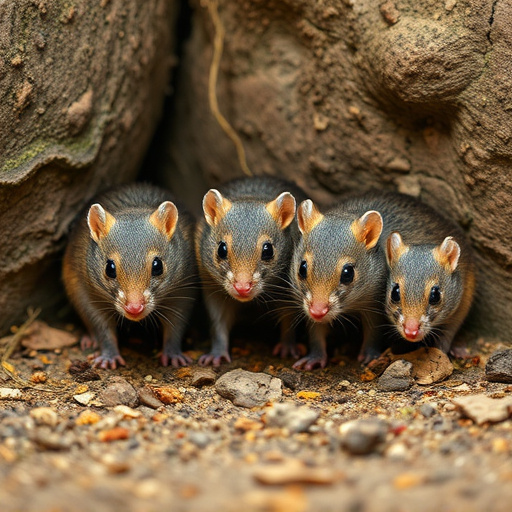Catalina Foothills Rodent Behavior & Control: Understanding Habitat Preferences for Effective Tucson Solutions
The Catalina Foothills near Tucson, Arizona, host diverse rodents like Black-tailed Chipmunks (Pacif…….

The Catalina Foothills near Tucson, Arizona, host diverse rodents like Black-tailed Chipmunks (Pacific Rats) and mouse species, each with unique behaviors and habitats. Cats, nocturnal hunters, patrol territories at twilight, while mice are diurnal foragers living in social colonies. Understanding these habits is crucial for effective and humane rodent control Tucson strategies, promoting coexistence within the region's diverse ecosystem. Mild winters and abundant rainfall create ideal conditions for many species, posing a complex rodent control challenge. Tailored strategies involve sealing entry points, regular trash removal, landscaping maintenance, trapping, and professional pest control services, using bait stations strategically placed around known activity areas to eliminate infestations.
In the vibrant, bustling Catalina Foothills region near Tucson, understanding rodent behavior is crucial for effective rodent control. This article delves into the intricate world of rodents, focusing on identifying common species, deciphering behavioral patterns, and exploring habitat preferences. By examining environmental factors that attract these pests, we provide tailored strategies for successful rodent control in Tucson homes and properties. Discover how to navigate this labyrinthine problem and reclaim your space.
- Identifying Rodent Species in the Catalina Foothills
- Behavioral Patterns and Daily Routines of Cats and Mice
- Habitat Preferences and Environmental Factors
- Effective Rodent Control Strategies for Tucson Homes and Properties
Identifying Rodent Species in the Catalina Foothills

The diverse ecosystems of the Catalina Foothills in Tucson, Arizona, play host to a variety of rodent species. Among them, the most common include the Pacific Rat, also known as the Black-tailed Chipmunk, and several mouse species such as the Deer Mouse and the House Mouse. These rodents are adept at adapting to various environments within the foothills, from dense forests to open grasslands. Their presence is often indicated by distinctive signs, such as chewed plant material, small mounds of feces, or tracks in muddy areas.
Identifying these species is crucial for anyone interested in rodent control Tucson methods. Each species has unique behaviors and habitats that inform effective management strategies. For instance, the Pacific Rat is more active during the day and tends to live in burrows near trees, while the Deer Mouse prefers nocturnal activity and seeks shelter in dense vegetation or abandoned structures. Understanding these habits allows for tailored approaches to deter or control rodent populations, ensuring the balance of the local ecosystem remains intact.
Behavioral Patterns and Daily Routines of Cats and Mice

In the vibrant landscape of Catalina Foothills, rodents like cats and mice exhibit distinct behavioral patterns and daily routines that are crucial to understanding their habitat preferences and, subsequently, implementing effective rodent control Tucson strategies. Cats, being nocturnal creatures, are most active during twilight hours when they hunt for food, patrol their territories, and interact with other cats or potential threats. Their exceptional night vision and agility make them adept at navigating the complex terrain of the foothills, allowing them to establish extensive home ranges that can cover several square kilometers.
Mice, on the other hand, are diurnal by nature, preferring to be active during the day when they forage for food, build nests, and raise their young. They tend to avoid open areas and prefer the protection of dense vegetation or man-made structures. Mice are highly social animals, often living in colonies, which can lead to rapid population growth if left unchecked. Understanding these behavioral differences is vital for humane and effective rodent control Tucson methods, ensuring that both cat and mouse populations can coexist harmoniously within the diverse ecosystem of Catalina Foothills.
Habitat Preferences and Environmental Factors

Rodents in the Catalina Foothills region of Tucson, Arizona, are highly influenced by their habitat preferences and environmental factors. These areas offer a unique blend of ecosystems, from dense forests to open grasslands, each providing distinct advantages for various rodent species. For instance, the abundant plant diversity offers rodents a wide range of food sources, while the complex terrain allows for shelter and protection from predators.
Environmental conditions play a crucial role in shaping their behavior and distribution. Factors such as temperature, precipitation, and available water significantly impact where rodents establish their habitats. In Tucson’s Foothills, the mild winters and abundant rainfall create favorable conditions for many species to thrive, making it an ideal rodent control challenge due to the diverse range of potential pests. Understanding these preferences is essential for implementing effective rodent control strategies tailored to this specific ecosystem.
Effective Rodent Control Strategies for Tucson Homes and Properties

In the pursuit of effective rodent control for Tucson homes and properties, understanding habitat preferences is key. Rodents like mice and rats are attracted to spaces that offer shelter, food, and water. Common entry points include gaps around pipes, cables, doors, and windows. Sealing these access points with materials like steel wool or caulk can significantly deter rodents. Regular trash removal and keeping outdoor areas clean are essential as rodents are drawn to uneaten food. Additionally, maintaining landscaping a certain way – removing dense foliage near the house and trimming trees – reduces hiding spots and makes it harder for rodents to enter.
For existing rodent infestations, a multi-pronged approach is most effective. This includes identifying and sealing entry points, setting traps, and employing professional pest control services when necessary. Using bait stations strategically placed around known rodent activity areas can be an efficient way to trap and eliminate them. It’s crucial to remember that different rodent species may require distinct control methods, so a tailored strategy is ideal. Effective rodent control in Tucson involves a proactive approach that combines prevention, clean living practices, and targeted interventions.
Understanding the behavior and habitat preferences of rodents in Catalina Foothills is crucial for effective rodent control in Tucson. By identifying species, recognizing their behavioral patterns, and understanding habitat needs, homeowners can implement tailored strategies to protect their properties. Integrating these insights with suitable control methods ensures a quieter, more secure living environment free from unwelcome visitors. For efficient rodent control Tucson residents should consider professional advice and eco-friendly solutions that address the unique challenges posed by local rodents.







